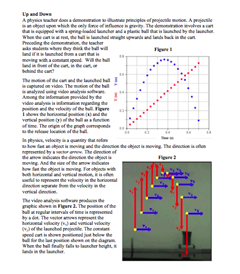 Up and Down
Up and Down
Resource:
Science Reasoning Center: Up and Down
Grade Level: High School
Description:
This passage from The Science Reasoning Center describes a demonstration in which a ball is launched upward from a cart moving at a constant speed. The motion of the ball is analyzed using video analysis and the results are presented in the form of a position (both x- and y-) vs. time graph and a velocity vector diagram. Questions target a student's ability to read, interpret, and interpolate from a graph, to formulate models that are consistent with data, and to translate information from one representation to another representation (e.g. from a diagram to a graph, and vice versa).
This activity aligns with the two of the three dimensions of the Next Generation Science Standards in the manner described below:
| Patterns: Different patterns may be observed at each of the scales at which a system is studied and can provide evidence for causality in explanations of phenomena. |
After even an introductory study of free fall motion, one will begin to see many natural patterns of motion that emerge. This data presentation is a filled with opportunities to explore such patterns. The symmetry of up and down motion, the constancy of horizontal velocity, and the independence of vertical and horizontal motions are three such patterns that will emerge from a study of this projectile motion data representation. |
| Analyzing and Interpreting Data: Analyze data using tools, technologies, and/or models (e.g., computational, mathematical) in order to make valid and reliable scientific claims or determine an optimal design solution. |
It is important that students are afforded the opportunity to use technologies and analysis tools as they study physics. In this experiment, video analysis tools were used to capture a dot diagram of a projectile. The first four questions at the end of the passage require students to analyze and interpret the results of the video analysis graph and video capture dot diagram. |
| Developing and Using Models: Develop or use a model based on evidence to illustrate the relationships between systems or between components of a system. |
As students are presented with multiple data models in the passage, they are asked to both use these projectile motion models as well as to develop their own model based on evidence to make claims. Questions 5, 7 and 8 are a nice example of how students are asked to develop a model from a given data set. |
| Engaging in Argument from Evidence: Make and defend a claim based on evidence about the natural world that reflects scientific knowledge, and student-generated evidence. |
While a discrepant event or demonstration of a common misconception can serve as an excellent way to capture the attention of students and provide a teachable moment, it is important that students then have the opportunity to make meaning of what they have just experienced in light of the principles they are studying. This passage provides a description of such a teacher demonstration and then provides opportunities for students to construct their own understanding of what they have experienced. Question 6, “Which statement below is most closely associated with the reason for the ball landing in the launcher?” is an example of how students are asked to engage in argument from evidence concerning such a discrepant event. |
Associated Reading from The Physics Classroom
Other Supporting Pages at The Physics Classroom:
View Infographic.
(Coming Soon)
Search the NGSS Corner
Maybe you're looking for something really specific that pertains to a desired topic and emphasizes one or more of the listed NGSS dimensions. Why not try a search of this section of our website? Simply select from one or more of the pull-down menus and click Search. This page will reload and a collection of possibilities will be displayed in this section of the page and sorted by relevancy.